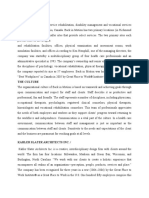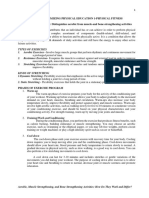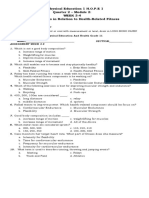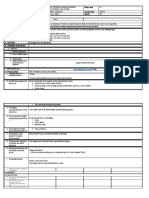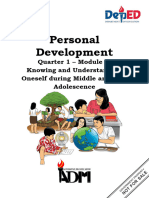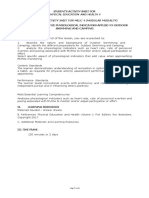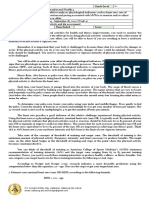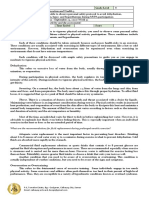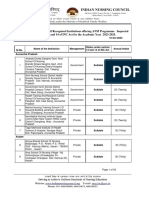Week 1 Pe 12 Activity Sheet
Week 1 Pe 12 Activity Sheet
Uploaded by
Denise Michelle AntivoCopyright:
Available Formats
Week 1 Pe 12 Activity Sheet
Week 1 Pe 12 Activity Sheet
Uploaded by
Denise Michelle AntivoOriginal Title
Copyright
Available Formats
Share this document
Did you find this document useful?
Is this content inappropriate?
Copyright:
Available Formats
Week 1 Pe 12 Activity Sheet
Week 1 Pe 12 Activity Sheet
Uploaded by
Denise Michelle AntivoCopyright:
Available Formats
Name Grade Level 12
Subject Physical Education 12
You will be able to self-assesses health-related fitness (HRF). status, barriers to
Objective
physical activity assessment participation and one’s diet
Date August 24-28, 2020 (Week 1)
Duration 4hrs (3hrs activity and 1hr assessment)
Time Started Time Ended Score
Components of Health Related Fitness
There are five areas of health related fitness. They are heart and lung endurance or cardiovascular endurance,
muscular strength, muscular endurance, flexibility, and body composition.
Heart and lung endurance or cardiovascular endurance is the ability to exercise the entire body for
long periods of time. It requires a strong heart, healthy lungs, and clear blood vessels to supply the body
with oxygen. Activities to improve fitness in this area include running, swimming and aerobic dance. A
person must do the activity continuously for a minimum of 20 minutes within their target heart rate
zone. Endurance/cardiovascular activity should be done a minimum of 3 days per week. Every other day
is preferable. The mile or the pacer will measure fitness testing in this area.
Muscular Strength is the amount of force you can put forth with your muscles. It is often measured by
how much weight you can lift. People with strength have fewer problems with backaches and can carry
out their daily tasks efficiently. Examples of muscular strength include push-ups, weight lifting heavy
weight with few repetitions, and pull-ups. Fitness testing will be measured by doing push-ups.
Muscular Endurance is the ability to use the muscles, which are attached to the bones, many times
without getting tired. People with good muscular endurance are likely to have better posture, have
fewer back problems, and be better able to resist fatigue than people who lack muscular endurance.
You can improve muscular endurance by lifting weights with many repetitions or doing sit-ups.
Measuring the number of sit ups you can do correctly is used for fitness testing.
Flexibility is the ability to use your joints fully. You are flexible when the muscles are long enough and
the joints are free enough to allow movement. People with good flexibility have fewer sore and injured
muscles. Stretching before and after activities will help to improve flexibility. The sit-and-reach and the
trunk lift are two tests used to measure flexibility.
Body Composition is the percentage of body weight that is fat compared to other body tissue, such as
bone and muscle. People who have a high percentage of fat are more likely to be ill and have a higher
death rate than lean people. Exercise and eating the right foods in the proper amounts can improve
body composition. Body composition can be measured using an instrument called calipers, a
specialized scale, or it can be calculated by using the body mass index (BMI) which uses height and
weight to determine your BMI.
Dance is a performing art and also physical education. When a student attends dance classes, both of these
subjects are addressed. Dance classes definitely play a role in attaining fitness. The term fitness is broadly used
and often vaguely defined. Many people perceive health and fitness as one and the same, yet there is a definite
distinction between the two concepts. Health reflects a person's state of being; it is typically viewed as the
presence or absence of disease.
Fitness, however, is the ability to do physical activity or to perform physical work. There are three
components of fitness: strength, flexibility, and endurance. It is the combination of these three components
that leads to the achievement of fitness. Knowing the fitness values and principles that apply to dance class can
provide motivation for working hard, working safely, and setting goals. Dance goes beyond the demands of
exercise. Dance is an art form that is mentally emotionally challenging. For the dancer, fitness is a worthwhile
by-product of the pursuit of perfection.
The Physical, Mental, and Social–Emotional Benefits of Dance
The physical and mental benefits of dance cannot be overstated. Dance improves cardiovascular health,
heightens balance and strength, boosts cognitive performance, and provides stress relief, all with low wear and
tear on the body.
P.6, Tomalon Estate, Bgy. Gadgaran, Calbayog City, Samar
Email: calbayog.arts.and.design@gmail.com
Physical
Dancing is a great cardio activity. The Department of Health and Human Services recommends 150–
300 minutes of moderate exercise or 75–150 minutes of vigorous aerobic activity per week. Depending
on the type, dance can easily fulfill either of these requirements, and make the time go by quickly too!
Dancing helps with balance and strength. Dance movements often tap into muscles and movements
we don’t typically use for daily activities, so practicing these motions can help improve our ability to
balance and build up little-used muscle strength.
Anyone can dance. That doesn’t mean everyone is good at dancing. Rather, dancing is an exercise that
people of all ages and physical abilities can participate in. Many forms of dance are easy on the body, so
even people with limited mobility or ongoing pain and injuries can learn the steps and take advantage
of dancing’s many benefits.
Mental
Dance enhances your cognitive performance. The brain needs oxygen and energy opens in new
window to function well, and dance helps your body produce both. Dance can also teach students to
focus and be more creative and disciplined, which are useful skills in any mental endeavor.
Dance is mentally challenging. Unlike some other forms of exercise, dance engages the brain on
many levels: You have to remember the steps, know how to shift from one movement into another, stay
coordinated with the music and other people, and maintain balance while doing all these things.
Social–Emotional
Dancing is social. Studies show opens in new window that dance taps into the same cooperative
movements required in sports and playing music together. During dance, people begin to emit the
same low-frequency brain waves, demonstrating the connection between participants.
Dancing improves your mood. Like many other forms of movement and exercise, dance has been
shown opens in new window to reduce stress, decrease anxiety and depression, and boost self-esteem.
It turns out dance breaks are a legitimate form of study break, after all.
Barriers to Physical Activity
Many technological advances and conveniences that have made our lives easier and less active, many
personal variables, including physiological, behavioural, and psychological factors, may affect our plans to
become more physically active. Understanding common barriers to physical activity and creating strategies to
overcome them may help make physical activity part of daily life. People experience a variety of personal and
environmental barriers to engaging in regular physical activity.
1. Personal Barriers
With technological advances and conveniences, people’s lives have in many ways become increasingly
easier, as well as less active. In addition, people have many personal reasons or explanations for being inactive.
The most common reasons adults don't adopt more physically active lifestyles are cited as:
insufficient time to exercise
inconvenience of exercise
lack of self-motivation
non-enjoyment of exercise
boredom with exercise
lack of confidence in their ability to be physically active (low self-efficacy)
fear of being injured or having been injured recently
lack of self-management skills, such as the ability to set personal goals, monitor
progress, or reward progress toward such goals
lack of encouragement, support, or companionship from family and friends
non-availability of parks, sidewalks, bicycle trails, or safe and pleasant walking
paths close to home or the workplace
The top three barriers to engaging in physical activity across the adult lifespan are:
time
energy
motivation
Other barriers include
cost
facilities
illness or injury
P.6, Tomalon Estate, Bgy. Gadgaran, Calbayog City, Samar
Email: calbayog.arts.and.design@gmail.com
transportation
partner issues
skill
safety considerations
child care
uneasiness with change
unsuitable programs
2. Environmental barriers
The environment in which we live has a great influence on our level of physical activity. Many factors in
our environment affect us. Obvious factors include the accessibility of walking paths, cycling trails, and
recreation facilities. Factors such as traffic, availability of public transportation, crime, and pollution may also
have an effect. Other environmental factors include our social environment, such as support from family and
friends, and community spirit. It is possible to make changes in our environment through campaigns to
support active transportation, legislation for safer communities, and the creation of new recreation facilities.
Overcoming Barriers
As health care professionals we can help people identify barriers to exercise and make suggestions for
how they can overcome these barriers. The Centers for Disease Control and Prevention makes suggestions for
overcoming physical activity barriers:
Lack of time Identify available time slots.
Monitor your daily activities for one week. Identify at least three 30-minute time slots you could use for
physical activity.
Add physical activity to your daily routine. For example, walk or ride your bike to work or shopping,
organize school activities around physical activity, walk the dog, exercise while you watch TV, park
farther away from your destination, etc.
Select activities requiring minimal time, such as walking, jogging, or stair climbing.
a. Social influence
Explain your interest in physical activity to friends and family. Ask them to support your efforts.
Invite friends and family members to exercise with you. Plan social activities involving exercise.
Develop new friendships with physically active people. Join a group, such as the YMCA or a hiking club.
b. Lack of energy
Schedule physical activity for times in the day or week when you feel energetic.
Convince yourself that if you give it a chance, physical activity will increase your energy level; then, try
it.
c. Lack of motivation
Plan ahead. Make physical activity a regular part of your daily or weekly schedule and write it on your
calendar.
Invite a friend to exercise with you on a regular basis and write it on both your calendars.
Join an exercise group or class.
d. Fear of injury
Learn how to warm up and cool down to prevent injury.
Learn how to exercise appropriately considering your age, fitness level, skill level, and health status.
Choose activities involving minimum risk.
e. Lack of skill
Select activities requiring no new skills, such as walking, climbing stairs, or jogging.
Take a class to develop new skills.
f. Lack of resources
Select activities that require minimal facilities or equipment, such as walking, jogging, jumping rope, or
calisthenics.
Identify inexpensive, convenient resources available in your community (community education
programs, park and recreation programs, worksite programs, etc.).
P.6, Tomalon Estate, Bgy. Gadgaran, Calbayog City, Samar
Email: calbayog.arts.and.design@gmail.com
g. Weather conditions
Develop a set of regular activities that are always available regardless of weather (indoor cycling,
aerobic dance, indoor swimming, calisthenics, stair climbing, rope skipping, mall walking, dancing,
gymnasium games, etc.)
h. Travel
Put a jump rope in your suitcase and jump rope.
Walk the halls and climb the stairs in hotels.
Stay in places with swimming pools or exercise facilities.
Visit the local shopping mall and walk for half an hour or more.
Bring your mp3 player your favorite aerobic exercise music.
ACTIVITY 1: Barriers to being active Quiz!
Instruction: Listed below are reasons that people give to describe why they do not get as much physical activity
as they think they should. Please read each statement and indicate how likely you are to say each of the
following statements by circling the number:
Very Somewhat Somewhat Very
How likely are you to say?
likely likely unlikely unlikely
1. My day is so busy now, I just don’t think I can make 3 2 1 0
the time to include physical activity in my regular
schedule.
2. None of my family members or friends like to do 3 2 1 0
anything active, so I don’t have a chance to exercise.
3. I’m just too tired after work/studies to get any 3 2 1 0
exercise.
I’ve been thinking about getting more exercise, but I just 3 2 1 0
can’t seem to get started
I’m getting older so exercise can be risky. 3 2 1 0
I don’t get enough exercise because I have never learned 3 2 1 0
the skills for any sport.
I don’t have access to jogging trails, swimming pools, 3 2 1 0
bike paths, etc.
Physical activity takes too much time away from other 3 2 1 0
commitments—time, work, family, etc.
I’m embarrassed about how I will look when I exercise 3 2 1 0
with others.
I don’t get enough sleep as it is. I just couldn’t get up 3 2 1 0
early or stay up late to get some exercise.
It’s easier for me to find excuses not to exercise than to 3 2 1 0
go out to do something.
I know of too many people who have hurt themselves by 3 2 1 0
overdoing it with exercise.
I really can’t see learning a new sport at my age. 3 2 1 0
It’s just too expensive. You have to take a class or join a 3 2 1 0
club or buy the right equipment.
My free times during the day are too short to include 3 2 1 0
exercise.
My usual social activities with family or friends to not 3 2 1 0
include physical activity.
I’m too tired during the week and I need the weekend to 3 2 1 0
catch up on my rest.
I want to get more exercise, but I just can’t seem to 3 2 1 0
make myself stick to anything.
I’m afraid I might injure myself or have a heart attack. 3 2 1 0
I’m not good enough at any physical activity to make it 3 2 1 0
fun.
If we had exercise facilities at school, then I would be 3 2 1 0
P.6, Tomalon Estate, Bgy. Gadgaran, Calbayog City, Samar
Email: calbayog.arts.and.design@gmail.com
more likely to exercise.
Follow these instructions to score yourself:
Enter the circled number in the spaces provided, putting together the number for statement 1 on line 1,
statement 2 on line 2, and so on.
Add the three scores on each line. Your barriers to physical activity fall into one or more of seven
categories: lack of time, social influences, lack of energy, lack of willpower, fear of injury, lack of skill,
and lack of resources. A score of 5 or above in any category shows that this is an important barrier for
you to overcome.
Example: Circled number
_2_ + __3__ + __3__ = ________8__________
Item number 1 8 15 Lack of time
SCORE:
____ + ____ + ____ = ______________________
1 8 15 Lack of time
____ + ____ + ____ = ______________________
2 9 16 Social influence
____ + ____ + ____ = ______________________
3 10 17 Lack of energy
____ + ____ + ____ = ______________________
4 11 18 Lack of willpower
____ + ____ + ____ = ______________________
5 12 19 Fear of injury
____ + ____ + ____ = ______________________
6 13 20 Lack of skill
____ + ____ + ____ = ______________________
7 14 21 Lack of resources
Processed Question:
1. What statement/s has the highest score?
________________________________________________________________________________________________
________________________________________________________________________________________________
2. Do you agree with the result? Why? Why not?
________________________________________________________________________________________________
________________________________________________________________________________________________
________________________________________________________________________________________________
________________________________________________________________________________________________
3. How will you overcome these barriers?
________________________________________________________________________________________________
________________________________________________________________________________________________
________________________________________________________________________________________________
________________________________________________________________________________________________
P.6, Tomalon Estate, Bgy. Gadgaran, Calbayog City, Samar
Email: calbayog.arts.and.design@gmail.com
ACTIVITY 2: Health Fitness Matching Type
Instruction: Match column B with column A. Write the correct complete answer before the number.
Column A Column B
_______1. You need to convince yourself that if A. Lack of resources
you give it a chance, physical activity will B. Social influence
increase your energy level. C. Muscular Strength
_______2. The ability where the muscle and joints D. Muscular Endurance
are free enough to move. E. Physical Benefit
_______3. This type of barrier includes the accessibility F. Environmental barrier
of recreational facilities, walking paths, and G. Lack of energy
bicycle roads. H. Fear of injury
_______4. Identify inexpensive, convenient resources I. Cardiovascular endurance
available in your community. J. Flexibility
_______5. People tend to have fewer problems with K. Personal barrier
backaches and can carry out their daily tasks L. Body Composition
efficiently. M. Dance
_______6. This type of art plays an important role in N. Weather condition
attaining fitness. O. Socio-emotional benefit
_______7. It is the percentage of body weight that is fat
compared to other body tissue, such as bone
and muscle.
_______8. It requires a strong heart, healthy lungs, and clear blood vessels to supply the body with oxygen.
_______9. Learn how to exercise appropriately considering your age, fitness level, skill level, and health status.
_______10. A type of barrier that relates to the interest in physical activity of friends and family.
_______11. Developing a set of regular activities that are always available regardless of weather.
_______12. People are likely to have better posture, have fewer back problems, and be better able to resist
fatigue.
_______13. Like many other forms of movement and exercise, dance reduces stress, decrease anxiety and
depression, and boost self-esteem.
_______14. People tend to become less active because of the technological advancements and convenience that
make lives easier.
_______15. Dance movements often tap into muscles and movements we don’t typically use for daily activities.
It
helps improve our ability to balance and build up little-used muscle strength.
ACTIVITY 3: Me and My Health!
Instruction:
Components Level of Intensity Effects How to
improve
Cardiovascular
Endurance
Zumba Dance Zumba Dance Zumba dance 6
for 2-3 minutes for 4-5 minutes minutes and up
Muscular Male: Male: Male:
Strength
8-10 push ups 11-16 push ups 17 and up push
ups
Female: Female: Female:
P.6, Tomalon Estate, Bgy. Gadgaran, Calbayog City, Samar
Email: calbayog.arts.and.design@gmail.com
5-8 push ups 9-13 push ups 14 and up push
ups
Muscular Male: Male: Male:
Endurance
Elbow plank Elbow plank Elbow plank
(30-45 seconds) (46-60 seconds) (more than 60
seconds)
Female: Female: Female:
Elbow plank Elbow plank Elbow plank
(20-35 seconds) (36-45 seconds) (46-60 seconds)
Flexibility
Head Rotation
(Right) 3x
(Left) 3x
Side Bend 8
seconds each
(Right)
(Left)
(Front)
(Back)
Body Male: Male: Male:
Composition
Squat jumps 8x Squat jumps 12x Squat jumps 15x
Female: Female: Female:
Squat jumps 4x Squat jumps 8x Squat jumps 12x
Note: Please indicate reason if student is not able to perform the given activity.
________________________________________________________________________________________________
________________________________________________________________________________________________
________________________________________________________________________________________________
P.6, Tomalon Estate, Bgy. Gadgaran, Calbayog City, Samar
Email: calbayog.arts.and.design@gmail.com
ANSWER KEYS
Activity 1: Barriers to being active Quiz!
Student’s answer may vary.
Activity 2: Health Fitness Matching Type
1. G
2. J
3. F
4. A
5. C
6. M
7. L
8. I
9. H
10. B
11. N
12. D
13. O
14. K
15. E
Activity 3: Me and my health
Student’s answer may vary.
Reference:
https://blog.advancementcourses.com/classroom-activities/dance-pe-class/
https://www.physio-pedia.com/Barriers_to_Physical_Activity
P.6, Tomalon Estate, Bgy. Gadgaran, Calbayog City, Samar
Email: calbayog.arts.and.design@gmail.com
You might also like
- Back in MotionDocument4 pagesBack in MotionIAmAbdullahNo ratings yet
- Techniques of PsychotherapyDocument2,580 pagesTechniques of PsychotherapySrinivasRoopi100% (17)
- Achievement Test PE 11 FinalDocument5 pagesAchievement Test PE 11 FinalJessa Edaño Dela CruzNo ratings yet
- PERDEV FIRST Periodical Test (2022)Document5 pagesPERDEV FIRST Periodical Test (2022)jeadryl LinatocNo ratings yet
- Hope 3 First Quarter Performance TaskDocument1 pageHope 3 First Quarter Performance TaskKevzz EspirituNo ratings yet
- Perdev DLP 2Document3 pagesPerdev DLP 2Roy DoleraNo ratings yet
- Week 4 B Lesson 4Document4 pagesWeek 4 B Lesson 4Chad Laurence Vinson CandelonNo ratings yet
- Tos - Midterm Contemporary Philippine Art From The RegionDocument1 pageTos - Midterm Contemporary Philippine Art From The RegionmlucenecioNo ratings yet
- PE and Health G-11Document1 pagePE and Health G-11Honiel PagoboNo ratings yet
- Hope 3 Quarter 1 Module 3Document22 pagesHope 3 Quarter 1 Module 3eunnice jelianNo ratings yet
- Hope 1.physical Fitness 2Document12 pagesHope 1.physical Fitness 2Aleck Celeres100% (1)
- Hope 1 Week3Document6 pagesHope 1 Week3Patrick John CarmenNo ratings yet
- Tos Hope 2 FinalDocument1 pageTos Hope 2 Finalabigail zagadoNo ratings yet
- Pe Grade 12Document3 pagesPe Grade 12Joylass PasacNo ratings yet
- HOPE 4 Module 2 PDFDocument32 pagesHOPE 4 Module 2 PDFKirin FallenNo ratings yet
- Module in Physical Education 11: Module Code: Pasay-PE11-Q2-W2Document3 pagesModule in Physical Education 11: Module Code: Pasay-PE11-Q2-W2Jay Kenneth BaldoNo ratings yet
- Hope 1 - Q2 - M12Document12 pagesHope 1 - Q2 - M12Artlyne BunuanNo ratings yet
- Monitoring Form: Grade 12 Career Guidance ModuleDocument2 pagesMonitoring Form: Grade 12 Career Guidance ModuleJC Rick Gel CaguisaNo ratings yet
- LESSON 2 Rewards of Engaging Oneself in PADocument2 pagesLESSON 2 Rewards of Engaging Oneself in PAkarla joy 05No ratings yet
- Lesson 2 Set Fitness GoalDocument28 pagesLesson 2 Set Fitness GoalJerwin Sarmiento100% (1)
- Pe 4 TosDocument2 pagesPe 4 TosThelma Ruiz SacsacNo ratings yet
- Lesson Plan in Relates Health BehaviorsDocument2 pagesLesson Plan in Relates Health Behaviorshartbreakershartbreak07No ratings yet
- Physical Education 1 H.O.P.E 1 Quarter 2 - Module 2: WEEK 3-4 Athletics in Relation To Health-Related FitnessDocument1 pagePhysical Education 1 H.O.P.E 1 Quarter 2 - Module 2: WEEK 3-4 Athletics in Relation To Health-Related FitnessSharon May JavierNo ratings yet
- Hope11 Diagnostic TestDocument5 pagesHope11 Diagnostic TestRhainne BernalNo ratings yet
- Peh12 q1 Module1 Danceintro v1Document23 pagesPeh12 q1 Module1 Danceintro v1luke ashtonNo ratings yet
- DLL Per Dev W1Document5 pagesDLL Per Dev W1Jenette CervantesNo ratings yet
- HOPE 1 Module 1 (Exercise For Fitness)Document10 pagesHOPE 1 Module 1 (Exercise For Fitness)Ma.Angelica B. Acedilla100% (1)
- Pilarlimin Sample RRL Embedded in The IntroductionDocument11 pagesPilarlimin Sample RRL Embedded in The IntroductionNikko B CalmaNo ratings yet
- Hope 3 Week 1Document3 pagesHope 3 Week 1Jane Bonglay100% (1)
- Physical Education and Health: Hope 3: DanceDocument5 pagesPhysical Education and Health: Hope 3: DanceHannah RodriguezNo ratings yet
- Physiological Indicators: Heart Rate Rate of Perceived Exertion PacingDocument29 pagesPhysiological Indicators: Heart Rate Rate of Perceived Exertion PacingAlyssa AlejandroNo ratings yet
- Lesson 2 Aerobic Activities Fitt PrincipleDocument14 pagesLesson 2 Aerobic Activities Fitt PrincipleNicklette PerosoNo ratings yet
- Demo DLLDocument4 pagesDemo DLLDhel SolomonNo ratings yet
- Peh12 - Week 1 To 3Document7 pagesPeh12 - Week 1 To 3Shiela MaeNo ratings yet
- HOPE 3 Lesson 1 Elements of DanceDocument29 pagesHOPE 3 Lesson 1 Elements of DanceJay El Taypin OrdanezaNo ratings yet
- PE 12 HOPE 3 Q2 Module 3 Lesson 6 7 by FarrahDocument32 pagesPE 12 HOPE 3 Q2 Module 3 Lesson 6 7 by FarrahNicki EspinosaNo ratings yet
- 21st Century Learning Activity SheetDocument3 pages21st Century Learning Activity SheetAMANE AMANODEN100% (1)
- Health Optimizing Physical Education 1: Quarter 1 - Module 2 Set Fitness GoalDocument30 pagesHealth Optimizing Physical Education 1: Quarter 1 - Module 2 Set Fitness GoalLara DisturaNo ratings yet
- 1st QT - Performance Task (PE and Health 11)Document7 pages1st QT - Performance Task (PE and Health 11)Sofie De LeonNo ratings yet
- What Does Magna Carta For Public School Teachers MDocument3 pagesWhat Does Magna Carta For Public School Teachers MVMembreve HazelNo ratings yet
- SHS-E-Class-Record-Core SubjectsDocument11 pagesSHS-E-Class-Record-Core SubjectsJefferson Cayaga Ordillas100% (1)
- NEW PNHS-SHS-P-E-Grade-12Document4 pagesNEW PNHS-SHS-P-E-Grade-12Charter Mar Lim JumawanNo ratings yet
- Department of Education: Republic of The PhilippinesDocument3 pagesDepartment of Education: Republic of The PhilippinesJabsTheKnightNo ratings yet
- Statement of PurposeDocument2 pagesStatement of PurposeBoyong ManatadNo ratings yet
- DLL-PER DEV-VV 6 - 2ndDocument4 pagesDLL-PER DEV-VV 6 - 2ndDesiree Manrique100% (1)
- Department of Education: San Miguel National High SchoolDocument2 pagesDepartment of Education: San Miguel National High SchoolVincent LagbasNo ratings yet
- Unit 1 Dance As A Health Enhancing Activity - 1Document21 pagesUnit 1 Dance As A Health Enhancing Activity - 1Kent Peter Cuadrado100% (1)
- DLL - Mil August 19-23, 2019Document4 pagesDLL - Mil August 19-23, 2019Rodjone Binondo100% (1)
- HOPE 12 Budget of WorkDocument2 pagesHOPE 12 Budget of WorkRonald Francis Sanchez VirayNo ratings yet
- FInal ExamDocument4 pagesFInal ExamLloydan EstacioNo ratings yet
- Perdev L 2Document20 pagesPerdev L 2Gil Bryanth LusaresNo ratings yet
- Health Related Fitness PPT WEEK 3 4Document17 pagesHealth Related Fitness PPT WEEK 3 4Ash LeyNo ratings yet
- Final DLLDocument4 pagesFinal DLLariannerose gonzalesNo ratings yet
- Hope 1 Lesson 1Document17 pagesHope 1 Lesson 1Ericka Dela CruzNo ratings yet
- Q1 SHS Personal Development Module 1Document15 pagesQ1 SHS Personal Development Module 1eljhoncariat36No ratings yet
- Hope 1 Week 1-4 DLLDocument8 pagesHope 1 Week 1-4 DLLLoreto MaluyoNo ratings yet
- Dance Injuries Power PointDocument20 pagesDance Injuries Power PointJerry Capitulo PorlucasNo ratings yet
- Nueva Estrella National High School: Second Quarter AssessmentDocument2 pagesNueva Estrella National High School: Second Quarter AssessmentMarlon Despoy0% (1)
- Department of Education: Weekly Home Learning PlanDocument12 pagesDepartment of Education: Weekly Home Learning PlanYuna CapellanNo ratings yet
- Sas - Hope 4 - Melc 4Document11 pagesSas - Hope 4 - Melc 4Justine BuenaventuraNo ratings yet
- Pe 11 Week 2 q2 Daily Lesson Log For TeachersDocument5 pagesPe 11 Week 2 q2 Daily Lesson Log For TeachersJUVANIE TINOYNo ratings yet
- PE 12 Q3 WK1-2 Understanding On Health Related FitnessDocument8 pagesPE 12 Q3 WK1-2 Understanding On Health Related FitnessEmarkzkie Mosra OrecrebNo ratings yet
- Learning Worksheet No. 1 Physical Education and Health 2Document2 pagesLearning Worksheet No. 1 Physical Education and Health 2Denise Michelle AntivoNo ratings yet
- Acr District Selection Meet 2017Document2 pagesAcr District Selection Meet 2017Denise Michelle AntivoNo ratings yet
- Activity Completion Report:: "2019 GLOBAL Handwashing Day Celebration"Document4 pagesActivity Completion Report:: "2019 GLOBAL Handwashing Day Celebration"Denise Michelle AntivoNo ratings yet
- Learning Worksheet No. 5 Physical Education and Health 11: Co Qah + Melc LWDocument3 pagesLearning Worksheet No. 5 Physical Education and Health 11: Co Qah + Melc LWDenise Michelle AntivoNo ratings yet
- Learning Worksheet No. 2 Physical Education 11Document4 pagesLearning Worksheet No. 2 Physical Education 11Denise Michelle AntivoNo ratings yet
- Learning Worksheet No. 3 Physical Education and Health 11Document5 pagesLearning Worksheet No. 3 Physical Education and Health 11Denise Michelle AntivoNo ratings yet
- Handout 1 - 11Document3 pagesHandout 1 - 11Denise Michelle AntivoNo ratings yet
- PE Handout 5 - GRADE 11Document5 pagesPE Handout 5 - GRADE 11Denise Michelle AntivoNo ratings yet
- PE Handout 4 - GRADE 11Document4 pagesPE Handout 4 - GRADE 11Denise Michelle AntivoNo ratings yet
- PE Worksheet 1 - GRADE 11Document2 pagesPE Worksheet 1 - GRADE 11Denise Michelle AntivoNo ratings yet
- PE Handout 3 - GRADE 11Document6 pagesPE Handout 3 - GRADE 11Denise Michelle AntivoNo ratings yet
- Oral Communication Quarter 1 Week 5Document6 pagesOral Communication Quarter 1 Week 5Denise Michelle AntivoNo ratings yet
- Week 4 PE 12 ACTIVITY SHEETDocument4 pagesWeek 4 PE 12 ACTIVITY SHEETDenise Michelle AntivoNo ratings yet
- PE Handout 2 - GRADE 11Document3 pagesPE Handout 2 - GRADE 11Denise Michelle AntivoNo ratings yet
- Week 5 PE 12 Activity SheetDocument8 pagesWeek 5 PE 12 Activity SheetDenise Michelle AntivoNo ratings yet
- UCSP Lesson 2Document26 pagesUCSP Lesson 2Denise Michelle Antivo0% (1)
- Week 2 Pe 12 Activity SheetDocument9 pagesWeek 2 Pe 12 Activity SheetDenise Michelle AntivoNo ratings yet
- Nature of Dances Pe Lesson 1Document32 pagesNature of Dances Pe Lesson 1Denise Michelle Antivo73% (11)
- Week 3 PE 12 ACTIVITY SHEETDocument3 pagesWeek 3 PE 12 ACTIVITY SHEETDenise Michelle AntivoNo ratings yet
- Dances in LuzonDocument13 pagesDances in LuzonDenise Michelle AntivoNo ratings yet
- Basic Dance GlossaryDocument3 pagesBasic Dance GlossaryDenise Michelle AntivoNo ratings yet
- Cause and Effect: The Epidemiological Approach: Raj BhopalDocument51 pagesCause and Effect: The Epidemiological Approach: Raj BhopalPatrick SevenNo ratings yet
- Case Study BPHDocument31 pagesCase Study BPHyhanne95% (84)
- Effect of Silymarin Plus Vitamin E in Patients With Non-Alcoholic Fatty Liver Disease. A Randomized Clinical Pilot StudyDocument7 pagesEffect of Silymarin Plus Vitamin E in Patients With Non-Alcoholic Fatty Liver Disease. A Randomized Clinical Pilot StudyJulio JuarezNo ratings yet
- Health Recovery From Toxic Mold Eguide 625 PDFDocument9 pagesHealth Recovery From Toxic Mold Eguide 625 PDFana bragaNo ratings yet
- Final Test English For Nurse Name: NIM: Class: 1. Look at The Picture For Number 1-2Document3 pagesFinal Test English For Nurse Name: NIM: Class: 1. Look at The Picture For Number 1-2Sri Sulistyawati AntonNo ratings yet
- Lactate MonitoringDocument6 pagesLactate Monitoringaliv8s3624No ratings yet
- Anm 10102023Document53 pagesAnm 10102023MANISHNo ratings yet
- Letter Fire DrillDocument4 pagesLetter Fire DrillmarivicvalerosocenonNo ratings yet
- Fispq-Bom Ar Air Wick FreshmaticDocument13 pagesFispq-Bom Ar Air Wick FreshmaticcarlosalexandremutNo ratings yet
- Food SanitationDocument10 pagesFood Sanitationsherly ameliaNo ratings yet
- Compliance To Factories & Machineries Act 1967 and RegulationsDocument3 pagesCompliance To Factories & Machineries Act 1967 and RegulationsmohdchemustafhaNo ratings yet
- PainDocument31 pagesPainihsanNo ratings yet
- Drug-Study MethyldopaDocument4 pagesDrug-Study MethyldopamayangernszNo ratings yet
- Amuse 2024 BookletDocument13 pagesAmuse 2024 BookletFebrine Wulansari GunawanNo ratings yet
- Microbiology Part 3Document74 pagesMicrobiology Part 3Authentic IdiotNo ratings yet
- Daftar PustakaDocument4 pagesDaftar PustakaHariz Ghulam RNo ratings yet
- Holiday Lighting Story With GraphicDocument2 pagesHoliday Lighting Story With GraphickourtneygeersNo ratings yet
- She Hha 2024 Year End Sept 2024Document4 pagesShe Hha 2024 Year End Sept 2024sleeNo ratings yet
- Weaver Et Al. - 2014 - Integrating Stages of Change Models To Cast New Vision On Interventions To Improve Global RetinoblasDocument12 pagesWeaver Et Al. - 2014 - Integrating Stages of Change Models To Cast New Vision On Interventions To Improve Global Retinoblaswj7t8w5zwnNo ratings yet
- Nutrition: What Is Healthy Eating?: Visual Art LESDocument33 pagesNutrition: What Is Healthy Eating?: Visual Art LESapi-313091355No ratings yet
- Paper 1Document9 pagesPaper 1Gloria JaisonNo ratings yet
- ICMM - Preventing FatalitiesDocument1 pageICMM - Preventing FatalitiesErick Jesus BallenaNo ratings yet
- DAFTAR PUSTAKA RefaratDocument3 pagesDAFTAR PUSTAKA RefaratLidyadewirahayuningsihNo ratings yet
- How To Prevent Illness in Winter SeasonDocument3 pagesHow To Prevent Illness in Winter SeasonsairafathimaaaNo ratings yet
- Graziani Et Al-2018-Periodontology 2000Document14 pagesGraziani Et Al-2018-Periodontology 2000Julio César PlataNo ratings yet
- RRLDocument30 pagesRRLbealinniNo ratings yet
- Bachelor of Pharmacy (Hons) 2023 - 2024 - FinalDocument77 pagesBachelor of Pharmacy (Hons) 2023 - 2024 - Finalmuhammed.agilyNo ratings yet
- Resilience in Cancer PatientsDocument44 pagesResilience in Cancer PatientsTasha NurmeilitaNo ratings yet
